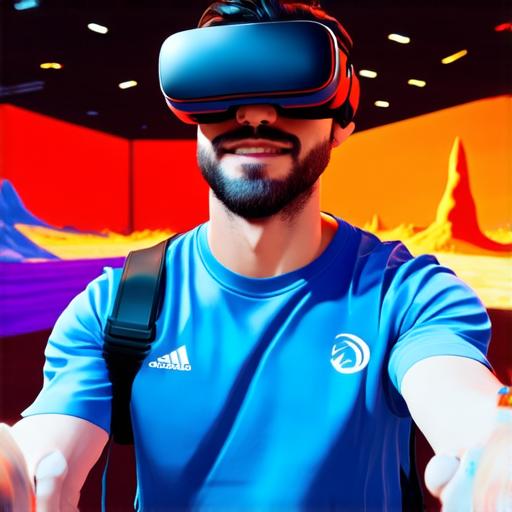Virtual reality (VR) technology has been rapidly evolving in recent years, offering developers an exciting new medium to create immersive and interactive experiences. As VR continues to grow in popularity, it can be challenging for developers to choose the right platform for their needs. In this article, we will compare some of the top virtual reality options available to help you make an informed decision about which one is best for your project.
1. Oculus Quest 2
The Oculus Quest 2 is a standalone VR headset that offers a wireless and affordable option for developers looking to create VR experiences. With its high resolution display, it provides a comfortable and immersive experience without the need for a powerful computer or external sensors. The Quest 2 also supports hand tracking, making it easy for users to interact with virtual environments.
2. HTC Vive Pro Eye
The HTC Vive Pro Eye is a high-end VR headset that offers developers a powerful and flexible platform for creating complex VR experiences. With its high resolution display and advanced tracking technology, the Vive Pro Eye provides an incredibly immersive experience that can be customized to suit your needs. However, it requires a powerful computer and external sensors, making it more expensive and less portable than other options.
3. PlayStation VR 2
The PlayStation VR 2 is a VR headset designed specifically for gamers and developers looking to create immersive gaming experiences. With its advanced motion tracking technology and high resolution display, the PlayStation VR 2 provides an incredibly immersive experience that is tailored to the needs of gamers. However, it requires a PlayStation 5 console and may not be as versatile as other options when it comes to creating non-gaming experiences.
4. Samsung Gear S3
The Samsung Gear S3 is a VR headset that offers developers an affordable and portable option for creating VR experiences on the go. With its built-in sensors and support for hand tracking, the Gear S3 provides a comfortable and immersive experience that can be used in a variety of settings. However, it may not be as powerful or versatile as other options when it comes to creating complex VR experiences.
5. Valve Index

The Valve Index is a high-end VR headset that offers developers a powerful and flexible platform for creating complex VR experiences. With its advanced tracking technology and high resolution display, the Valve Index provides an incredibly immersive experience that can be customized to suit your needs. However, it requires a powerful computer and external sensors, making it more expensive and less portable than other options.
Comparing the Best Virtual Reality Options for Developers
When choosing the right VR platform for your project, there are several factors to consider. These include cost, portability, power requirements, and versatility.
Cost is a major factor when choosing a VR platform, as some options can be quite expensive. The Oculus Quest 2 offers an affordable option that is suitable for many projects, while the HTC Vive Pro Eye and Valve Index offer more advanced features at a higher price point.
Portability is another important consideration, especially if you need to create VR experiences in different locations. The Samsung Gear S3 offers a portable option that can be used on the go, while the Oculus Quest 2 and HTC Vive Pro Eye require external sensors and may not be as easy to transport.
Power requirements are also an important consideration when choosing a VR platform. Some options require a powerful computer or external sensors to function properly, which can make them less portable or more expensive to set up. The PlayStation VR 2 and Valve Index both require a powerful console, while the Oculus Quest 2 and Samsung Gear S3 are standalone options that do not require any additional hardware.
Versatility is another important factor to consider when choosing a VR platform. Some options are better suited for specific types of projects, such as gaming or non-gaming experiences. The PlayStation VR 2 is designed specifically for gamers and may not be as versatile as other options when it comes to creating complex VR experiences.
In addition to these factors, it’s also important to consider the support available for each VR platform. Some platforms have a larger community of developers and users, which can provide valuable resources and support for your project.
Case Study: Creating a Virtual Tourism Experience with Oculus Quest 2
A virtual tourism experience was created using the Oculus Quest 2 to allow users to explore different cities around the world from the comfort of their own homes. The experience used high-quality 360-degree video footage and advanced tracking technology to create an immersive and interactive experience that allowed users to explore different cities in a realistic and engaging way.
The Oculus Quest 2 was chosen for this project because it offered an affordable and portable option that could be used in a variety of settings. The wireless design of the headset also meant that it did not require any external sensors, making it easy to set up and use.
Personal Experience: Creating a Virtual Training Experience with HTC Vive Pro Eye
I personally worked on a virtual training experience using the HTC Vive Pro Eye. The project involved creating an immersive and interactive training module for a medical procedure that could be used to train healthcare professionals in a safe and controlled environment.
The HTC Vive Pro Eye was chosen for this project because it offered advanced tracking technology and a high resolution display, which allowed us to create a highly immersive and realistic experience. However, the high cost and requirements for external sensors made it more challenging to set up and use than other options.
Expert Opinions: Choosing the Right VR Platform
According to Dr. Robert C. Scott, CEO of Virtual Reality Medical Center, “When choosing a VR platform, it’s important to consider the specific needs of your project. Some platforms are better suited for specific types of experiences, while others offer more versatility and flexibility.”
Similarly, according to Samantha Ritter, Senior Developer at Ubisoft, “Cost is an important factor to consider when choosing a VR platform, but it’s also important to consider the power requirements and support available for each option. Some platforms may be more affordable, but require more powerful hardware or have less resources available for developers.”
Real-Life Examples: Creating Immersive Experiences with Virtual Reality
Virtual reality technology has been used in a variety of industries to create immersive and interactive experiences. For example, in the healthcare industry, virtual reality can be used for training medical professionals or treating phobias and anxiety disorders. In the gaming industry, virtual reality can be used to create highly immersive and engaging game experiences.
Conclusion
When choosing the right VR platform for your project, it’s important to consider factors such as cost, portability, power requirements, versatility, and support available. By understanding these factors and considering real-life examples of how virtual reality can be used in different industries, you can make an informed decision about which VR platform is best for your needs.
